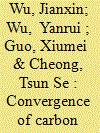| Srl | Item |
| 1 |
ID:
150890


|
|
|
|
|
| Summary/Abstract |
This paper investigates the spatial dynamics of per capita carbon dioxide (CO2) emissions in China. The analyses are conducted by employing a continuous dynamic distribution approach and panel data of 286 cities at the prefecture and above-prefecture level. The results show that per capita CO2 emissions tend to converge during the sample period of 2002–2011. However, multimodality is found in the ergodic distribution of the full sample. It is also found that there is more persistence in cities with low per capita CO2 emissions, and more mobility in cities with high per capita CO2 emissions. The analyses also show that the dynamics of per capita CO2 emissions are significantly different among various geographical, income and environmental policy groups. The conditional distribution analyses indicate that multimodality cannot be explained independently by any one of the two factors, namely geographical location or income level. The findings in this study may have important policy implications for CO2 abatement in China.
|
|
|
|
|
|
|
|
|
|
|
|
|
|
|
|
| 2 |
ID:
153055


|
|
|
|
|
| Summary/Abstract |
The spatial distribution of population and economic activities has important impacts on both economic growth and the environment. This paper uses a slack-based measure to estimate the total factor environmental efficiency (TFEE) of 286 Chinese prefectural-and-above cities for the period 2002–2013. In particular, the relationship between city size and TFEE is investigated. The findings also show an inverted U-shaped relationship between TFEE and city size, which implies an optimal city size of 16.68 million residents in China. According to this estimate, most Chinese cities may be undersized due to the migration restrictions of the hukou registration system and, hence, suffer from great environmental efficiency losses. The estimated low average TFEE value of Chinese cities also suggests the large potential for efficiency improvement. Thus, government policies should focus on relaxing migration restrictions and encouraging the development of large cities.
|
|
|
|
|
|
|
|
|
|
|
|
|
|
|
|
| 3 |
ID:
160862


|
|
|
|
|
| Summary/Abstract |
This paper examines total factor efficiency and productivity performance by taking into account local government debt (LGD) in 31 Chinese provincial regions for the period 2000–2013. The results show that neglecting LGD may overstate economic performance in Chinese provinces. The eastern region shows better performance in single factor efficiency and total factor efficiency than the non‐eastern regions. The western region shows the worst total factor performance. The north‐eastern region is the only region that has experienced a decline in total factor performance. The state‐dominated, investment‐driven development model may help technological progress across Chinese regions but could lead to significant factor misallocation. We argue that biases towards more state‐dominated investment and land supply in less productive western, central and north‐eastern regions, at the expense of investment and land supply in more productive eastern regions, have contributed to the recent slowdown in economic growth in China. Therefore, further market‐oriented reforms in factor markets should be considered in the future.
|
|
|
|
|
|
|
|
|
|
|
|
|
|
|
|